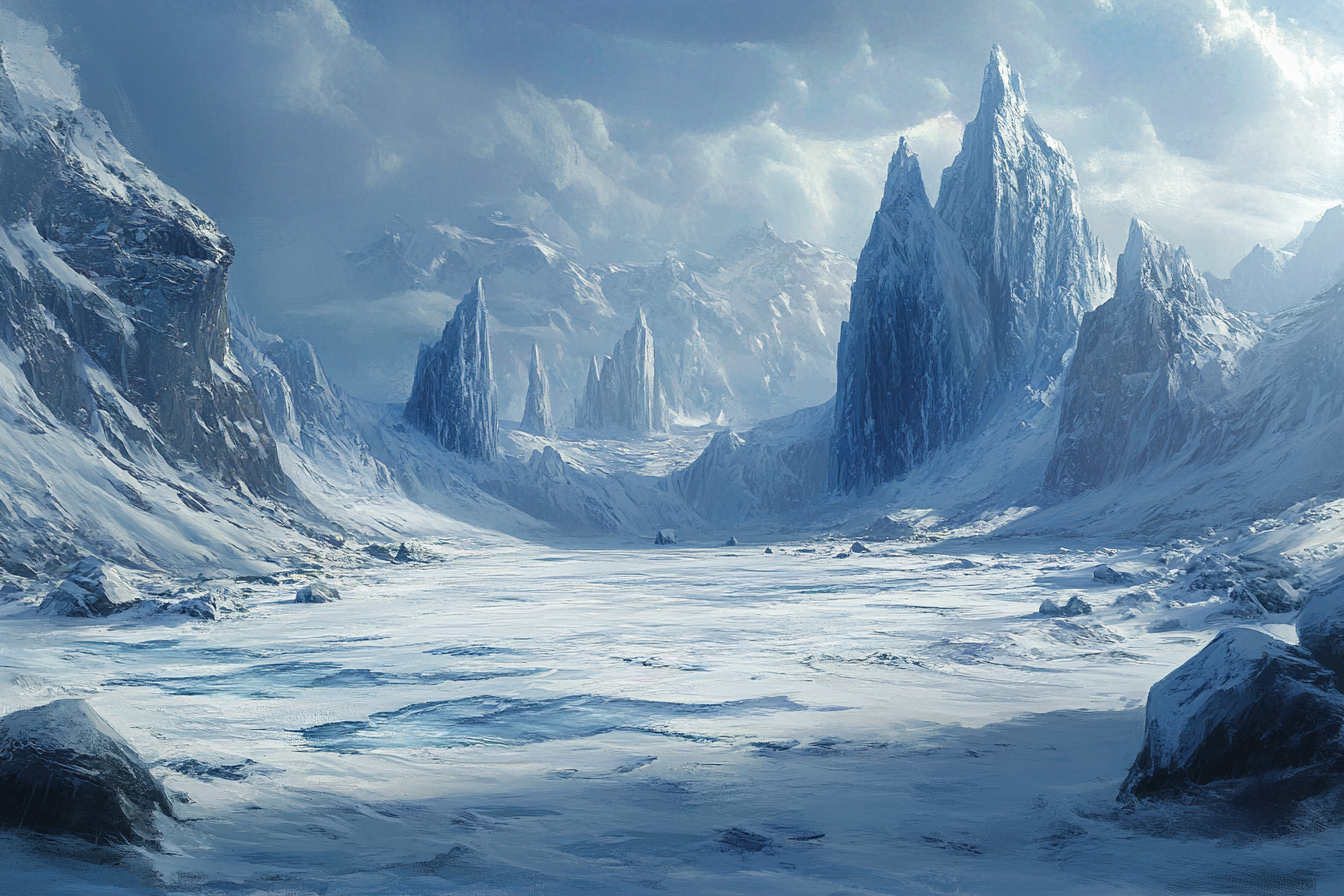Frostmire Tundra
The Frostmire Tundra, an expansive frozen wasteland located in the far northern reaches of the known world, has long been a land of mystery and peril. Bordering the Frozen Sea to the northeast, the Ironclad Valley to the northwest and imposing the Serpent Spine Range to the south, the tundra's geography is defined by vast stretches of permafrost, jagged ice formations, and a relentless, unforgiving climate. The tundra remains one of the most inhospitable regions in the world, with temperatures often plummeting to -50°C (-58°F) during the long, dark winters.
Despite its harsh environment, the Frostmire Tundra has been home to various nomadic tribes, including the formidable Urthrak Orcs and the elusive Frost Giant clans. These groups have adapted to the tundra's extreme conditions, carving out a precarious existence amidst the snow and ice. The tundra's unique ecosystem supports a sparse but resilient array of flora and fauna, such as frost drakes, snow wolves, and the mammoth herds that roam the frozen plains.
The history of the Frostmire Tundra is steeped in mystery, with remnants of ancient civilizations buried beneath the ice, their origins and fates largely unknown. These lost civilizations left behind enigmatic ruins that continue to intrigue scholars and adventurers alike. The tundra has also been the site of numerous conflicts, as various tribes and factions vie for control over its precious resources, including the rare and coveted Froststeel.
One of the most striking features of the Frostmire Tundra is the Auroras of the Eternal Night, a breathtaking natural phenomenon that lights up the winter skies with vibrant colors. These auroras, believed to be manifestations of ancient, magical energies, have long been a source of fascination and fear among those who inhabit the tundra.
Although the Frostmire Tundra remains largely unexplored due to its treacherous conditions, it continues to draw the interest of those seeking adventure, knowledge, and untold riches. The tundra's harsh beauty and enigmatic history make it a region of enduring significance in the annals of the world's history, a place where the past and present are eternally frozen in time.
Geography
The Frostmire Tundra is an expansive, frozen wasteland stretching for hundreds of miles in every direction. The land is predominantly flat, broken only by occasional jagged ice formations, frozen rivers, and the towering Ironclad Peaks that mark its southern boundary. The tundra is covered in permafrost year-round, with snow and ice blanketing the ground even during the brief summer months. Blizzards are frequent, and the landscape is often shrouded in a thick, icy fog.
Ecosystem
The ecosystem of the Frostmire Tundra is harsh and unforgiving. Life here is sparse, with only the hardiest of creatures able to survive. The tundra is home to a unique variety of flora and fauna adapted to the extreme cold, including snow wolves, frost drakes, and mammoth herds. Vegetation is limited to low-lying shrubs, lichens, and hardy grasses that can withstand the icy conditions.
Ecosystem Cycles
The tundra experiences extreme seasonal cycles. The winter months are long, with the sun barely rising above the horizon, plunging the land into near-perpetual darkness. Summer is brief, with long days of weak sunlight that only slightly warm the surface. The transition between these seasons is marked by violent storms and rapid temperature shifts, which can be deadly to those unprepared.
Localized Phenomena
The Frostmire Tundra is known for the Auroras of the Eternal Night, a breathtaking display of lights that dance across the sky during the long winter nights. These auroras are believed to be caused by magical energies emanating from deep within the earth. The tundra is also home to the Whispering Winds, a mysterious phenomenon where the wind carries the faint sounds of voices, often leading travelers astray.
Climate
The climate of the Frostmire Tundra is subarctic, characterized by long, frigid winters and short, cool summers. Temperatures often plummet to dangerous levels, with winter temperatures reaching as low as -50°C (-58°F). The wind chill can make it feel even colder, and snowstorms can last for days, making travel perilous.
Fauna & Flora
Flora: The vegetation of the Frostmire Tundra is limited but resilient. Frostroot is a common plant, known for its medicinal properties and ability to grow beneath the snow. Ice Thistle is another notable plant, with its thorny, crystalline appearance and ability to store water in its roots.
Fauna: The tundra is home to formidable creatures such as Frost Drakes, large reptilian beasts with icy breath, and Snow Wolves, pack hunters adapted to the cold. Mammoths roam the tundra in herds, their thick fur and massive size protecting them from the cold. Smaller creatures like Snow Hares and Arctic Foxes also inhabit the region, relying on their white fur for camouflage.
Natural Resources
The Frostmire Tundra is rich in natural resources, though they are difficult to extract. Vast deposits of Froststeel, a rare and incredibly strong metal, lie beneath the permafrost. The tundra also contains Ice Crystals, which are valued for their magical properties and are used in various alchemical and enchantment processes.
History
The Frostmire Tundra has a long and storied history, though much of it is shrouded in mystery. It was once home to ancient civilizations, now lost to time, whose ruins still dot the landscape. These civilizations are believed to have been wiped out by a cataclysmic event, leaving only their frozen remnants behind. The tundra has been a site of many battles between the nomadic tribes that roam its expanse, particularly over control of the precious resources buried beneath the ice.
Tourism
Few outsiders venture into the Frostmire Tundra due to its harsh conditions, but those who do are often adventurers seeking the treasures hidden within the icy wasteland. The tundra’s Auroras of the Eternal Night attract scholars and mages who study the magical phenomena, while the ruins of ancient civilizations draw archaeologists and treasure hunters. However, the risks of the tundra are great, and only the most prepared survive to tell the tale.



Comments